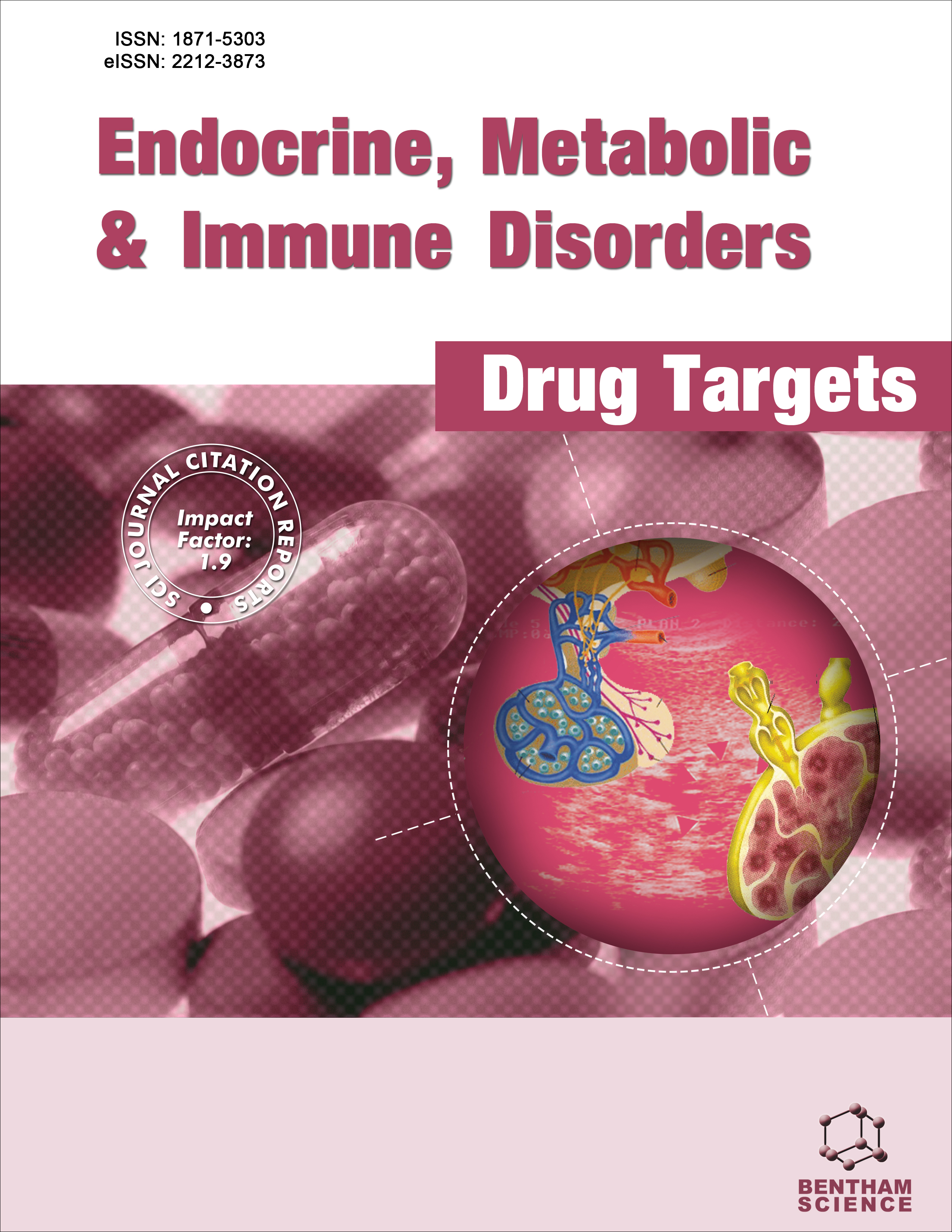- Home
- A-Z Publications
- Endocrine, Metabolic & Immune Disorders-Drug Targets (Formerly Current Drug Targets - Immune, Endocrine & Metabolic Disorders)
- Previous Issues
- Volume 22, Issue 12, 2022
Endocrine, Metabolic & Immune Disorders-Drug Targets (Formerly Current Drug Targets - Immune, Endocrine & Metabolic Disorders) - Volume 22, Issue 12, 2022
Volume 22, Issue 12, 2022
-
-
Targeting Citrate Carrier (CIC) in Inflammatory Macrophages as a Novel Metabolic Approach in COVID-19 Patients: A Perspective
More LessAuthors: Mahsa E. Vakili, Zahra Saleh, Dieter Kabelitz and Kurosh KalantarCoronavirus disease-19 (COVID-19) can be a fatal disease and is caused by severe acute respiratory syndrome coronavirus 2 (SARS-CoV2). SARS-CoV2 is an enveloped virus that belongs to the Beta coronavirus subfamily. After entering into the target cells, this virus replicates rapidly and leads to cellular damage and uncontrolled pulmonary inflammation. Huge amounts of inflammatory cytokines and chemokines are produced Read More
-
-
-
Metainflammation in COVID-19
More LessAuthors: Mojtaba Bakhtiari and Kamyar AsadipooyaA new coronavirus pandemic, caused by severe acute respiratory syndrome coronavirus 2 (SARS-CoV-2), has been on the rise. This virus is fatal for broad groups of populations, including elderly, men, and patients with comorbidities among which obesity is a possible risk factor. The pathophysiologic connections between obesity/metainflammation and COVID-19 may be directly related to increasing soluble ACE2 (ang Read More
-
-
-
Effects of Bacterial Metabolites on the Immune System: Enemies and Friends
More LessMetabolites produced by bacteria can influence the immune system. These metabolites are produced by pathogenic bacteria as well as the friendly microbiota. This review sheds light on the major bacterial metabolites and their structures. It also describes the capacity of these molecules to stimulate and inhibit the immune responses in a way that affects their capacity to control different diseases.
-
-
-
Bilirubin and Epigenetic Modifications in Metabolic and Immunometabolic Disorders
More LessBilirubin is the main waste product of heme catabolism. At high concentrations, bilirubin may cause toxicity, especially in the brain, kidney, and erythrocytes. Membrane and mitochondrial dysfunction, oxidative stress, apoptosis, necrosis, endoplasmic reticulum stress, excitotoxicity, inflammation, and epigenetic modifications are the main mechanisms of toxicity triggered by bilirubin in susceptible organs. Many studie Read More
-
-
-
Reducing Proteoglycan Synthesis and NOX Activity by ROCK Inhibitors: Therapeutic Targets in Atherosclerosis
More LessAtherosclerosis is a chronic inflammatory disease of the arteries characterized by the accumulation of inflammatory cells in the arterial wall. Hypertension, dyslipidemia, and hyperglycemia are major risk factors of atherosclerosis. Rho-associated protein kinase (ROCK), a serine/threonine kinase, is a downstream effector of the small GTPase RhoA. ROCK is involved in different stages of atherosclerosis. Accumulating eviden Read More
-
-
-
Immunometabolism in the Bladder Cancer Microenvironment
More LessAuthors: Mohammad J. Fattahi, Mohammad Reza Haghshenas and Abbas GhaderiThe initiation and progression of bladder cancer (BC) are dependent on its tumor microenvironment (TME). On the other hand, cancer cells shape and train TME to support their development, respond to treatment and migration in an organism. Immune cells exert key roles in the BC microenvironment and have complex interactions with BC cells. These complicated interplays result in metabolic competition in the TME Read More
-
-
-
Obesity and Adipose Tissue-derived Cytokines in the Pathogenesis of Multiple Sclerosis
More LessAuthors: Gholamreza Daryabor, Zahra Amirghofran, Nasser Gholijani and Peyman BemaniMultiple sclerosis (MS) is a chronic autoimmune neurodegenerative disease of the central nervous system (CNS) characterized by demyelination, neuronal loss, and permanent neurological impairments. The etiology of MS is not clearly understood, but genetics and environmental factors can affect the susceptibility of individuals. Obesity or a body mass index of (BMI) > 30 kg/m2 is associated with serious health consequences Read More
-
Volumes & issues
-
Volume 25 (2025)
-
Volume 24 (2024)
-
Volume 23 (2023)
-
Volume 22 (2022)
-
Volume 21 (2021)
-
Volume 20 (2020)
-
Volume 19 (2019)
-
Volume 18 (2018)
-
Volume 17 (2017)
-
Volume 16 (2016)
-
Volume 15 (2015)
-
Volume 14 (2014)
-
Volume 13 (2013)
-
Volume 12 (2012)
-
Volume 11 (2011)
-
Volume 10 (2010)
-
Volume 9 (2009)
-
Volume 8 (2008)
-
Volume 7 (2007)
-
Volume 6 (2006)
Most Read This Month
Article
content/journals/emiddt
Journal
10
5
false
en


